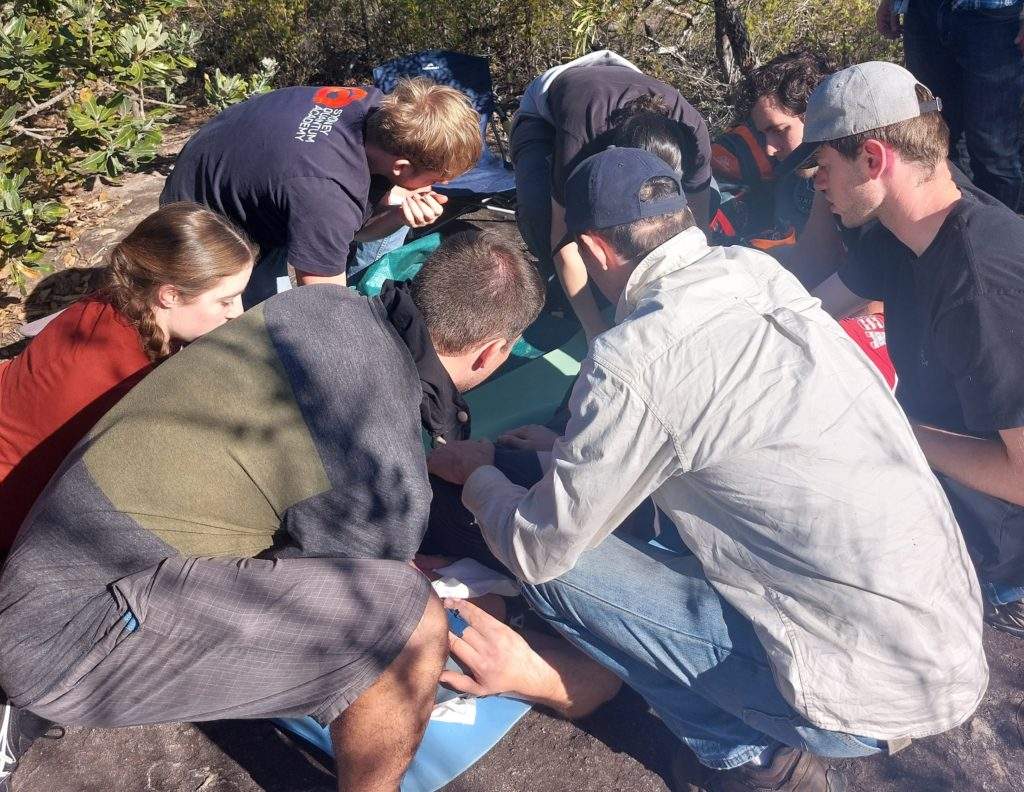Warning: This article contains imagery with fake blood and fake injuries along with discussions about first aid situations. Please note that all scenarios were fictional and ideas were pulled from the International Canyon Database, which I highly recommend checking out if you’re like me and want to figure out what mistakes not to make https://canyonaccident.org/.
As outdoorsy people, we constantly chase the adrenaline that comes from those amazing experiences we get from extreme sports, in wild locations. We are an adventurous bunch, and the sports we love are practiced in demanding environments in remote locations. This means we need to be prepared for the risks that come from these environments and for the trip leaders this is where first aid training comes in.
In a remote location, when a disaster hits, you need to be calm and collected, able to think on your feet managing the physical and emotional safety of the group, send for help and communicate well. Constantly practicing and upskilling first aid skills is a great way to keep yourself sure that if an incident did occur, you’re as prepared as can be.
The trip:
Last Saturday a group of trip leaders with their RAFA (remote area first aid) or WFA (wilderness first aid) got together at Manly Dam to practice those skills, both the technical skills of dealing with a number of first aid scenarios (which we’ll come to later) and the communication and patient management needed to handle patients and responders in a remote location, knowing that help may be several hours away.
The first aiders gather around our spinal patient (Safety Officer Brendan)
We all learnt a lot over the course over the day and I’d like to hope we are all feeling that bit more prepared to go out into the wilderness.
The surveys:
Those of you who have done your basic first aid through work or surf life saving will have heard of the primary survey, or the DRSABC (danger, response, send for help, airways, breathing/blood, compression/circulation). When you’re in the wilderness, with multiple hours before help can arrive, we still carry out the DRSABC along with what’s known as a secondary survey (where they check for other bleeding, breaks, patient history, movement of fingers and toes, all the fun stuff). Throughout the day during our scenarios the first aiders prioritized carrying out the primary survey, getting the patient off the ground and warm and dry and then that secondary survey. Practising these skills over and over means they become muscle memory and hopefully if the day finally comes that we need those skills they’ll come back like that.
The individual scenarios:
Throughout the day we covered two types of scenarios: individual scenarios in which the group would split into patients and responders with each responder having to manage a patient with one injury/incident and the mass scenario.
We covered a huge amount of material in the individual scenarios, covering burns, heat exhaustion/dehydration, musculoskeletal injuries (sprains/breaks), anaphylaxis (thanks to Ollie for providing us with real expired epipens to practice on oranges!), snake/spider bites complete with fake snakes and spiders, diabetes, cardiac issues, seizures, asthma and dislocations.
Everyone was very excited to get that fake blood out, and being a horror connoisseur I had purchased some little pump bottles to get the blood out (I got this idea from Gareth at the WFA course who told me that an arterial bleed does look a lot like this).
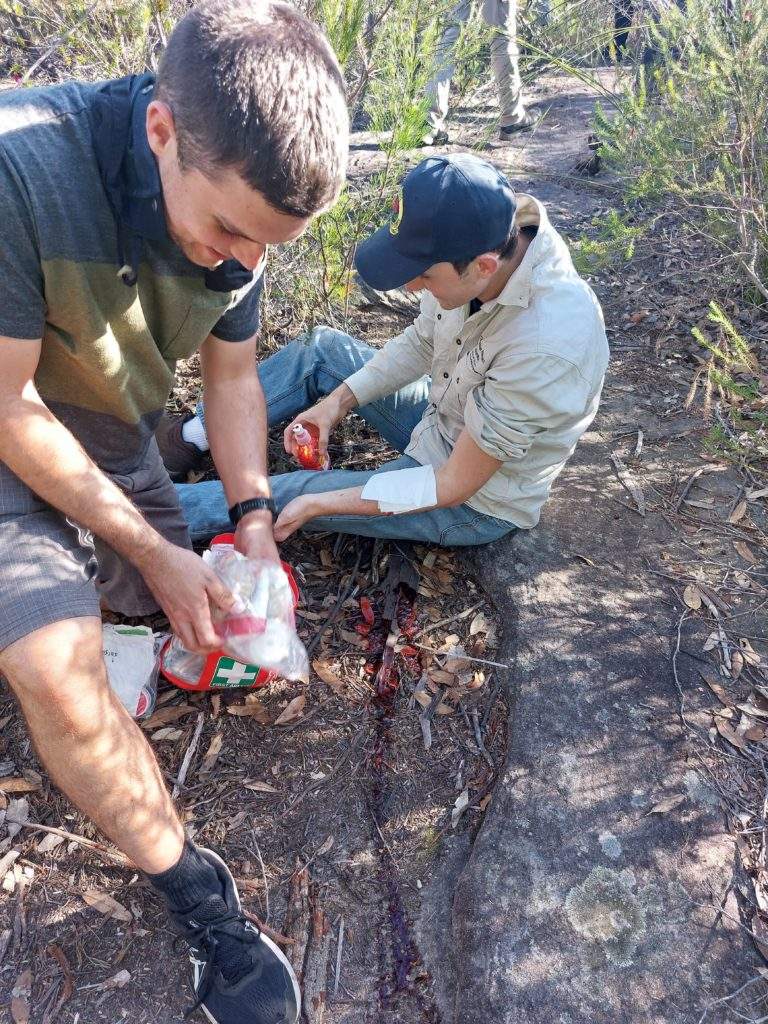
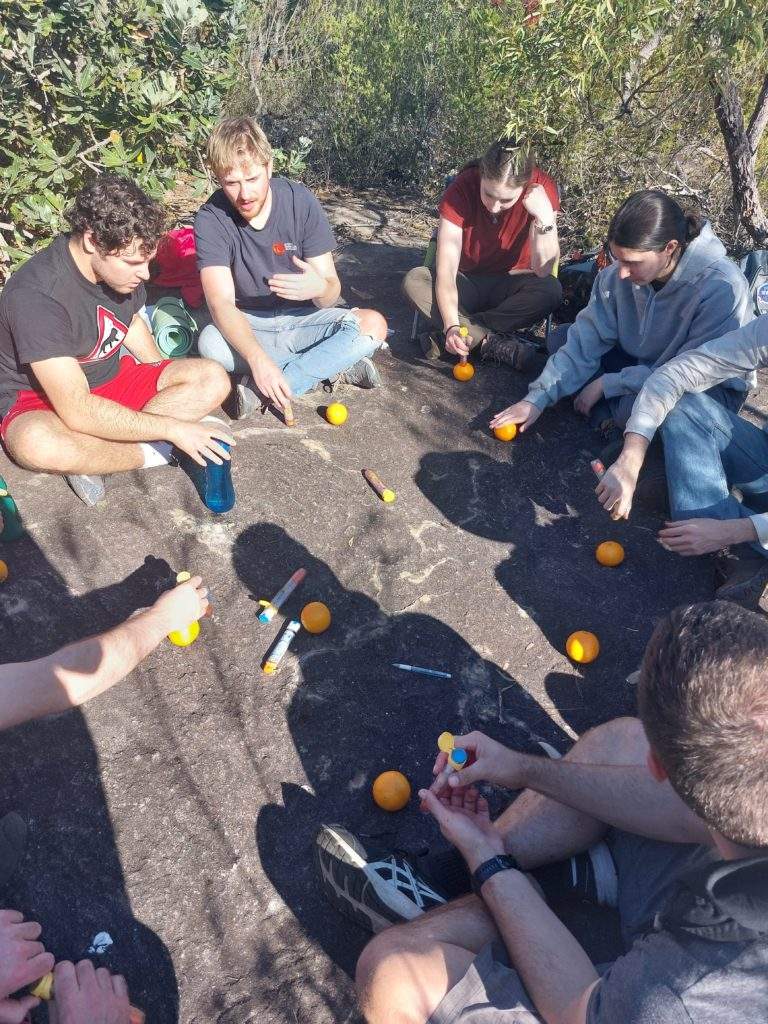
Left: First aider (and vice president) Bennett rushes to stop the pump bottle bleeding as Daniel (our web officer) has the time of his life pretending to be in agony. Right: Jayden (events officer) and Ollie (trip coordinator) who are both allergic to peanuts help us practice with epi-pens on oranges.
The spinal
The culmination of these individual scenarios was the spinal, a situation where you suspect the patient to have had a spinal injury based on the MOI (mechanism of injury – usually falling but sometime from being hit by things). In remote locations, especially places like canyons where its hard to rescue someone where an incident occurred we don’t get the luxury of not moving our spinal patients and we also don’t have the luxury of a spinal board. Enter the BEAM lift, a way of turning your first aiders into a spinal board. With gentle hands and great communication from the person on the head, our first aiders were able to carry Brendan over 20m of uneven terrain whilst keeping him bundled up and secure.
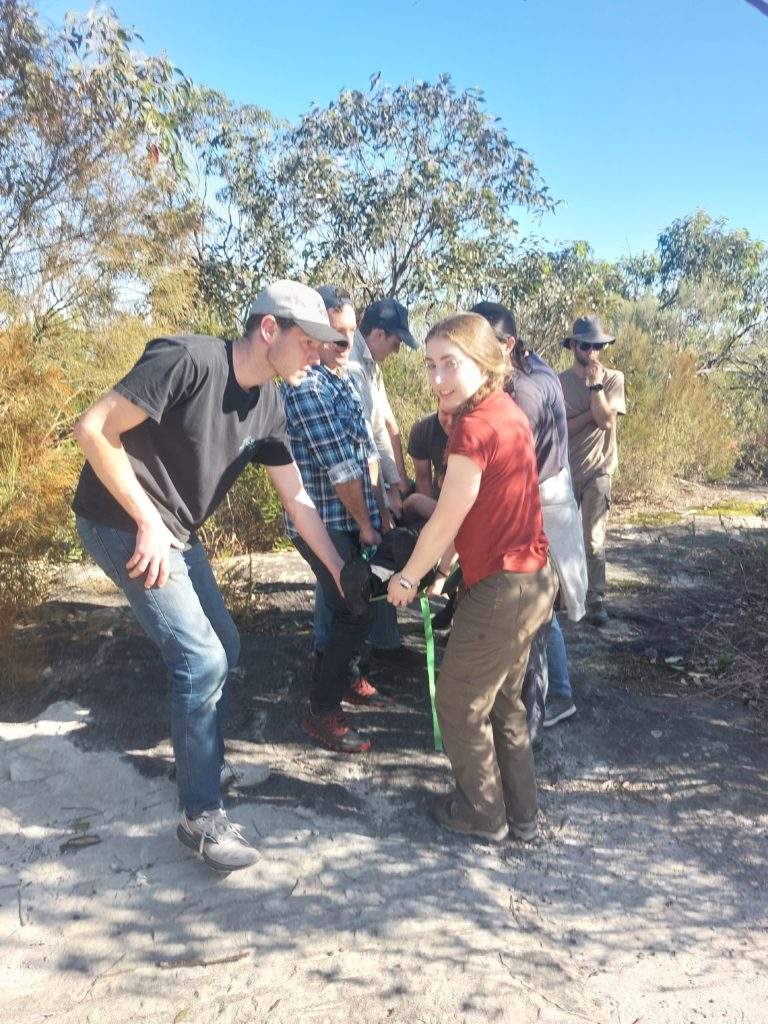
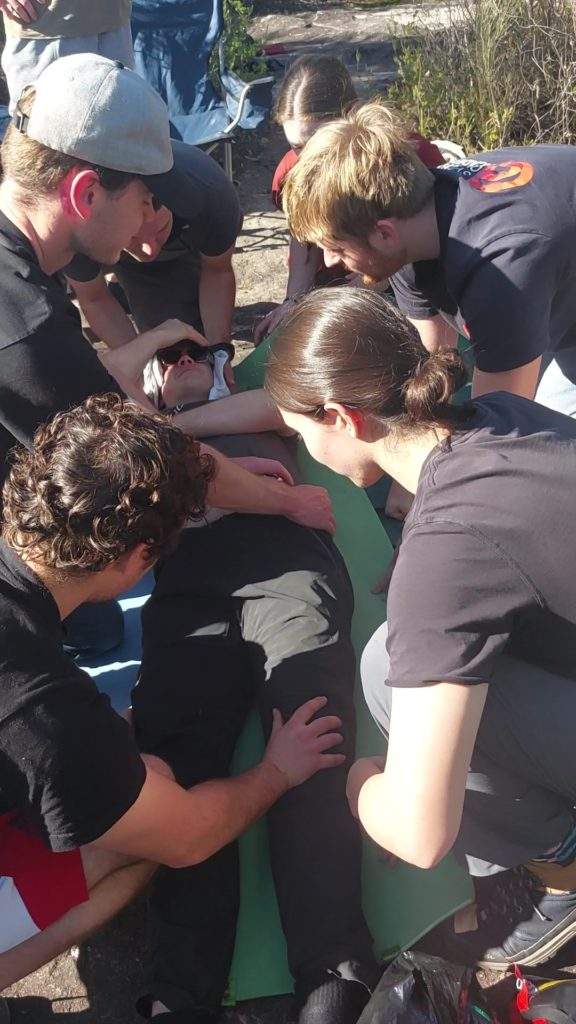
Left: the first aiders carry Brendan (safety officer) by using the BEAM technique. Right: Brendan taking a nap while the team get organised.
The mass scenario (description of first aid scenarios ahead):
With two hours left on the clock, we rolled into my favourite, the mass scenario. As a surf life saver I love the mass scenario as it reminds me of my life guard training days. It’s the best way for the first aiders to practice working together as a team, having to manage multiple incidents and possible dangers and not least keeping up morale.
We split the team into two to simulate the group size of some of our smaller group trips. Felix, Amelia K, Daniel and Bennett were put in the climbing group while Sam, Jayden, Amelia V, Brendan and Ryan were allocated to the canyoning incident.
The climbers
Allow me to set the scene. The climbers have heard a loud noise from around the corner at their crag, and when they went to investigate, they found a boulder had come loose, crushing our poor patient Niels’ arm and causing him a head injury. Climbing with an atc, he had then dropped patient Gabe N, who had broken his leg, fractured his spine and bruised a rib. The climbing first aiders responded quickly, calling emergency services (me over at the canyoners scenario with my phone) in less than five minutes, and working with only four people stabilized the patients for the two hours it took for help (me again) to arrive. I wasn’t there to watch this scenario but phone calls to me as emergency services appeared calm.
Unfortunately my grand vision for a rock crushing reminiscent of 127 hours didn’t play out, as the tiny rock we had used in place of a boulder fell off Niels’ arm as the responders attended to him. This resulted in some quick acting spurred on by his military first aid training which told him a crushed arm can release toxins to the body if the object is removed. Cue Niels pretending to go into shock.
The canyoners
The canyoners had a very different scene. They have just finished Claustral canyon as part of Freeze Fest and are walking up the exit when they notice a lot of flow coming through the canyon and some screams. Patient Leo and patient Niki had been caught in a flash flood, with both of them hypothermic, covered in scrapes. Leo had also sustained a broken arm, and Niki unbeknownst to the team had drowned, and was to surprise them by needing CPR about 30 minutes in for a pulmonary edema in a situation that used to be referred to as secondary drowning.
Once again despite Ollie and my evil scheming for a scenario, the team responded quickly and calmly and safety officer Brendan even had time by the end to have a mock chat with patient Leo about his work. The team finished up the scenario by carrying out two BEAM lifts of the patients which Leo enjoyed so much he wanted them to keep carrying him.
Learnings of the day:
We all learnt a lot throughout the day about patient management, keeping calm during a crisis and communicating with others. Here are some of the things we learnt:
- Communication with emergency services can be really hard. As ‘emergency services’ I was sending through constant texts which were actually forwarded from a real life situation I had been involved in, asking for location etc. For Felix who did the call for help, this made it hard to be involved in the actual first aiding as I was constantly asking for extra information (I may have been a bit over the top)
- If there’s been a spider or snake bite, don’t try to catch the animal like they tell you to do in town, this is very dangerous! If you can, take a picture and try to stay away from it. Also Sydney funnel web spiders love hanging out in shoes
- Using a real epi-pen is not as scary as it seems if you properly follow the instructions. Having two first aiders who carry epi-pens all the time made it super easy
- If you suspect someone has a broken femur (the bone in the thigh) you need to traction it as soon as possible. The team who dealt with this were mostly RAFA certified (which doesn’t cover traction splints) but without a splint just constantly pulling on the leg to fatigue the muscle will do
- Drowning doesn’t necessarily happen instantly, and anyone whose suspected to have taken in water should be immediately evacuated and watched for over 24 hours (this is more of a thing in sea water)
- Having a coordinator who covers the scene but doesn’t get caught up in a small part is the most efficient way to figure out how to take care of people. Luckily for us on trips, this can almost always be a trip leader
- If you take a club first aid kit on a canyon, dry it out after. We had some pretty manky bandages in one poor first aid kit that hadn’t been dried
- First aid kits should carry snake bite bandages, inhalers, epi-pens and antihistamines. I 100% recommend carrying your own inhaler and antihistamines on a trip as you don’t know who else might have asthma or allergies (we found out a mate had an allergy to jellyfish on a kayaking trip and having antihistamines for their hives was a game changer)
- Get creative: at the WFA and RAFA first aid courses we practiced with hefty first aid kits and tarps/tents, on a day canyon you might not have all the gear you need. Some cool creative solutions I’ve heard of are backpack straps as a handline, backpack belt as a hip splint for hip breaks, carabiners to tighten tourniquets and jumpers tied to sticks/walking poles as a makeshift stretcher
- If you’re considering applying to get first aid or especially WFA or RAFA, do it! The accident at Sweet Dreams last weekend shows that sometimes us trip leaders can get into trouble too, and one of the best things you can do to prepare for the outdoors (aside from adequate gear checks, risk awareness and weather forecasts) is to have first aid
- Our trip leaders are amazing, resourceful and quick on their feet!
Thanks again to everyone who made this day possible, to Ollie my amazing co-trip leader who had to listen to me float scenario ideas for about three months before the event and our patients Niels, Gabe N, Leo and Niki for coming all the way to Manly dam just to pretend to be dying.




